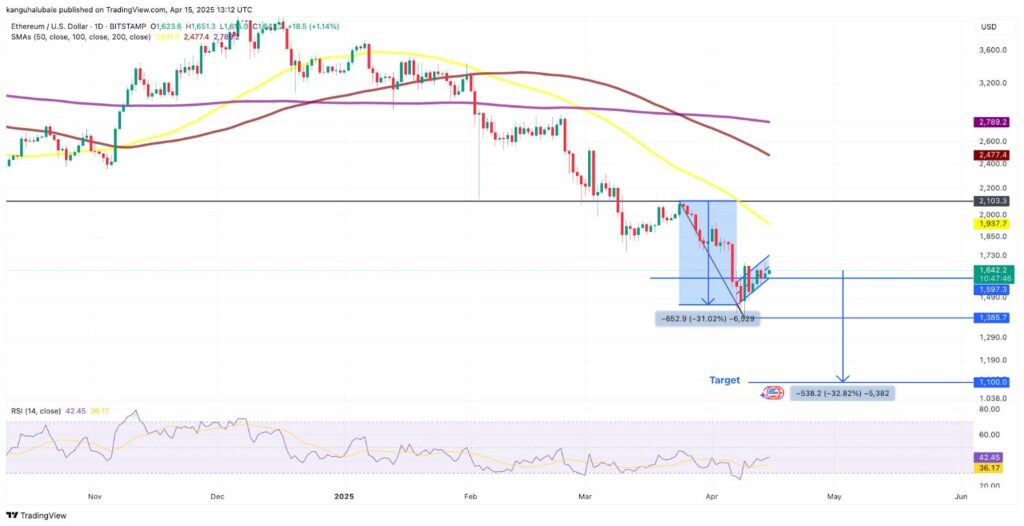The cryptocurrency market is currently witnessing a significant shift, with Ether (ETH) nearing all-time lows. As of April 9, Ethereum’s market dominance has dipped to an alarming 7.18%, a near multiyear low that raises concerns among investors and analysts alike. According to data from Cointelegraph Markets Pro and TradingView, this figure is perilously close to the all-time low of 7.09% recorded in September 2019.
“Ethereum dominance is so very close to registering new all-time lows,” noted the well-respected crypto analyst Rekt Capital in a recent post.
Market analysts attribute this downturn to a variety of factors, including waning institutional interest, as evidenced by negative exchange-traded fund (ETF) flows, a lackluster derivatives market, and increasing competition from other layer-1 blockchains. In stark contrast, competitors like XRP have seen their market dominance surge by over 200% during this same period. Moreover, layer-1 rivals such as BNB Chain and Solana have experienced significant increases, with their market shares rising by 40% and an astonishing 344%, respectively, since the start of 2023.
The situation grows more complex when examining Ethereum’s total value locked (TVL) in decentralized finance (DeFi). Although Ethereum still leads with a 51.7% market share, this figure has plummeted from 61.2% in February 2024. In comparison, Solana has seen a remarkable 172% increase in TVL during the same timeframe, further solidifying its position as a formidable competitor.
With the price of ETH showing signs of a bearish trend, analysts are closely monitoring a classic pattern known as a “bear flag.” Should the Ethereum price close below its flag’s lower boundary of $1,600, a considerable drop toward the $1,100 mark could be on the horizon, indicating a potential 33% decline from current levels. Key indicators, including the relative strength index (RSI), also reflect a market trend that leans towards further downside, with the RSI remaining below the 50 mark.
As Ethereum continues to navigate this challenging landscape, the eyes of the crypto community remain focused on its future performance amidst increasing competition and fluctuating market dynamics.
Ethereum’s Market Struggles and Potential Consequences
As Ethereum (ETH) approaches critical market lows, several key points outline the current situation and its possible implications for investors and the cryptocurrency landscape:
- Market Dominance at All-Time Lows:
- Ethereum’s market dominance hit a multiyear low of 7.18%, close to the all-time low of 7.09% from September 2019.
- Ethereum’s dominance is crucial for maintaining its competitive edge against rising altcoins such as XRP, BNB, and Solana.
- Weak Institutional Demand:
- Negative ETF flows and a sluggish derivatives market indicate that institutional interest in Ethereum is waning.
- This reduction in institutional demand could further pressure Ethereum’s price and market performance.
- Competitive Threats:
- Competing layer-1 blockchains are gaining traction, with Solana’s total value locked (TVL) increasing by 172% compared to Ethereum’s decline from 61.2% to 51.7% in the same period.
- The rise of competitors suggests that Ethereum may lose market share, which can impact its innovation and network activity.
- Bearish Price Trends:
- A bear flag pattern on ETH’s chart indicates a potential price drop target of $1,100, representing a 33% decrease from current levels.
- The relative strength index (RSI) remaining below 50 suggests continued downward momentum in the market.
This information suggests that readers should be cautious and informed about their investments in Ethereum, as its market position and pricing could significantly impact their financial decisions and potential losses.
Ethereum’s Struggles Highlight the Competitive Crypto Landscape
The current landscape for Ethereum (ETH) casts a shadow of concern as its market dominance hovers at historic lows. A bearish pattern suggests an impending price decline potentially targeting $1,100, stirring discussions among investors and analysts alike. With Ethereum’s market share slipping to 7.18%, its competitive position is increasingly precarious, especially compared to rivals like XRP, which has surged by over 200% during the same period. This shift underscores a crucial advantage for XRP and others, indicating a growing preference for alternatives in the blockchain space.
The trend is not isolated to XRP, as other formidable technologies such as BNB Chain (BNB) and Solana (SOL) are witnessing significant gains in user adoption and capital liquidity. As Ethereum’s total value locked (TVL) decreases from 61.2% to a mere 51.7%, the rise of Solana by 172% creates an alluring narrative for investors seeking more robust financial ecosystems. Ethereum’s challenges might signal trouble for long-term holders and institutional investors, leading them to reconsider their positioning.
Moreover, the ongoing lack of institutional demand is evident through negative ETF flows, paving the way for a potentially dire future for ETH. If Ethereum’s price closes below the $1,600 mark, as analysts suggest, it could trigger a domino effect exacerbating its bearish trend. This situation affects not only Ethereum investors but could also have ripple effects on the broader crypto market by undermining confidence among those who have heavily invested in Ethereum-based projects.
In essence, Ethereum’s dilemma presents both challenges and opportunities. Those looking to reallocate investments or shift to more promising alternatives may benefit by exploring these competitive platforms. However, established Ethereum supporters may find this period fraught with anxiety as the narrative increasingly leans towards the capabilities of rival blockchains.

















